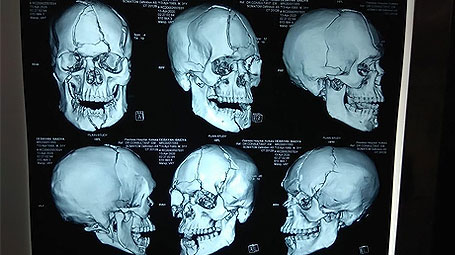Road Traffic Accident
- Home
- Road Traffic Accident






Whether from a motor vehicle accident, assault or other incident, facial trauma can cause pain, loss of function, and a disfigured appearance. Dr Abhik Pyne, oral and maxillofacial surgeon discuss the impact of facial fractures, soft tissue injuries and other aspects of facial trauma, and how plastic and reconstructive surgery can restore function and form.
Facial trauma is bone or soft tissue damage to the face caused by motor vehicle accidents, assaults (including gunshots), sports injuries, falls, chemical exposures, thermal burns or animal bites. Because the human face is an intricate area containing many bones, blood vessels, nerves, muscles and sensory organs, if untreated, facial trauma may cause a permanent loss of function (seeing, chewing, speaking, swallowing) and disfigurement if not treated. Working together, emergency doctors, plastic and reconstructive surgeons, and other practitioners can lessen this risk of permanent complications.
Depending on the type of injury, facial trauma can cause severe bleeding and swelling, a bruised face, and distorted appearance of the facial features.
The first stage of treatment for a person with a facial injury due to a motor vehicle accident, fall, burn, animal bite or assault takes place in the emergency department. There, the patient gets a full, head-to-toe trauma evaluation and emergency management of any life-threatening conditions.
Doctors, nurses and technologists work together to control bleeding and swelling and assess and manage effects of the facial trauma on the person’s airway, brain and vision. Facial injuries can be associated with:
After careful physical examination in the emergency room, imaging tests using computed tomography, or CT, is the most effective way to assess face trauma, since it allows imaging of bone, soft tissue, blood vessels and other structures.
Repairing Traumatic Facial Injuries
For deep cuts or lacerations to soft tissue, abrasions or fractures of the bones of the face, the ER doctors will likely refer the patient to a plastic and reconstructive surgeon.
The surgeons stress the importance of clear communication between patients and the plastic and reconstructive surgeons. Practitioners need to be receptive to the patients’ priorities, hopes and concerns, and patients should understand the surgical options available, the treatment plan and the outcomes they can expect.
Patients often have questions about the technical aspects of surgery,” dr. pyne says “For instance, when we have to repair bone fractures with plates and screws, patients will ask if it will remain in their face.” (It will, he says, adding that the materials are compatible with the patient’s tissues.) “They wonder if titanium plates or screws will set off metal detectors.” (They won’t.)
The objectives of treating someone with facial trauma using plastic and reconstructive surgery are:
Dr. Pyne explains his first priority is restoring function: the patient’s ability to see, breathe, chew, swallow, speak and move facial features. But he adds that surgery to ensure the facial features work properly can take the patient’s appearance into account.
“Our decision-making process, as oral and maxillofacial surgeons, focuses on how can we gain the best functional outcome while considering what the treated area is going to look like afterward. For instance, if we are repairing a major lower jaw fracture, we don't want to scar the skin, so we may go through the mouth.”
“We as maxillofacialsurgeon use our understanding of normal healing and that's why we use both physical exam and CT. Our experience with repairing congenital facial deformity and cancers affecting the face help us understand the recovery process,” he says, adding that surgical planning usually starts with soft tissues and then considers whether broken facial bones are likely to heal on their own or require surgical reconstruction.
Treatment for tears or crush injuries to the skin, nerves, glands or muscles may include microvascular reconstructive surgery — one or more intricate procedures to repair areas of soft tissue that have been cut or torn while reestablishing nerve connections and blood flow.
Facial injuries can involve peripheral nerves such as the cranial nerves that allow movement and sensation of the eyes.
“We need to document any neurologic problems early,” Yang says. “In patients with an injury to the upper third of their face and who are having difficulty moving eyes or eyelids, this could be due to blood collection behind eye, which can eventually cause blindness. We need to make sure we catch those issues early to preserve eyesight.”
Surgical treatment of facial fractures may include:
Dr. Abhik Pyne and his team may collaborate on your care with colleagues in other specialties to ensure your optimal treatment and recovery from facial trauma.
Fortunately, facial trauma in children is relatively rare. When it comes to treating kids’ traumatic facial injuries, Dr. Pyne states that reconstruction and recovery can be complex and necessitate long-term monitoring.
“In a growing child, the bones, teeth and facial shape are still developing,” explains Dr. Pyne. “Trauma to certain areas may have an impact ― including bones that may not grow as much as they could normally. Skull deformity can cause issues later on.
“We have to counsel patients and their caregivers to help them understand monitoring as the child grows. We may follow kids’ progress for months or even years to make sure any areas affected by trauma are healing properly.”